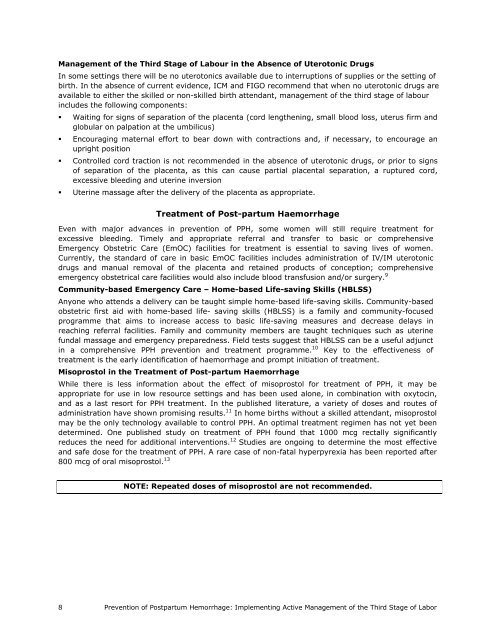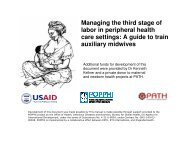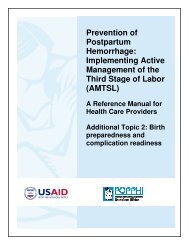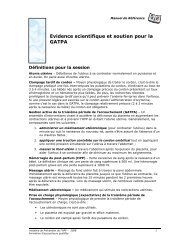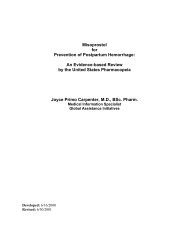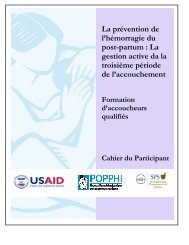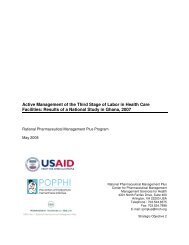Implementing Active Management of the Third Stage of Labor
Implementing Active Management of the Third Stage of Labor
Implementing Active Management of the Third Stage of Labor
Create successful ePaper yourself
Turn your PDF publications into a flip-book with our unique Google optimized e-Paper software.
<strong>Management</strong> <strong>of</strong> <strong>the</strong> <strong>Third</strong> <strong>Stage</strong> <strong>of</strong> Labour in <strong>the</strong> Absence <strong>of</strong> Uterotonic Drugs<br />
In some settings <strong>the</strong>re will be no uterotonics available due to interruptions <strong>of</strong> supplies or <strong>the</strong> setting <strong>of</strong><br />
birth. In <strong>the</strong> absence <strong>of</strong> current evidence, ICM and FIGO recommend that when no uterotonic drugs are<br />
available to ei<strong>the</strong>r <strong>the</strong> skilled or non-skilled birth attendant, management <strong>of</strong> <strong>the</strong> third stage <strong>of</strong> labour<br />
includes <strong>the</strong> following components:<br />
<br />
<br />
<br />
<br />
Waiting for signs <strong>of</strong> separation <strong>of</strong> <strong>the</strong> placenta (cord leng<strong>the</strong>ning, small blood loss, uterus firm and<br />
globular on palpation at <strong>the</strong> umbilicus)<br />
Encouraging maternal effort to bear down with contractions and, if necessary, to encourage an<br />
upright position<br />
Controlled cord traction is not recommended in <strong>the</strong> absence <strong>of</strong> uterotonic drugs, or prior to signs<br />
<strong>of</strong> separation <strong>of</strong> <strong>the</strong> placenta, as this can cause partial placental separation, a ruptured cord,<br />
excessive bleeding and uterine inversion<br />
Uterine massage after <strong>the</strong> delivery <strong>of</strong> <strong>the</strong> placenta as appropriate.<br />
Treatment <strong>of</strong> Post-partum Haemorrhage<br />
Even with major advances in prevention <strong>of</strong> PPH, some women will still require treatment for<br />
excessive bleeding. Timely and appropriate referral and transfer to basic or comprehensive<br />
Emergency Obstetric Care (EmOC) facilities for treatment is essential to saving lives <strong>of</strong> women.<br />
Currently, <strong>the</strong> standard <strong>of</strong> care in basic EmOC facilities includes administration <strong>of</strong> IV/IM uterotonic<br />
drugs and manual removal <strong>of</strong> <strong>the</strong> placenta and retained products <strong>of</strong> conception; comprehensive<br />
emergency obstetrical care facilities would also include blood transfusion and/or surgery. 9<br />
Community-based Emergency Care – Home-based Life-saving Skills (HBLSS)<br />
Anyone who attends a delivery can be taught simple home-based life-saving skills. Community-based<br />
obstetric first aid with home-based life- saving skills (HBLSS) is a family and community-focused<br />
programme that aims to increase access to basic life-saving measures and decrease delays in<br />
reaching referral facilities. Family and community members are taught techniques such as uterine<br />
fundal massage and emergency preparedness. Field tests suggest that HBLSS can be a useful adjunct<br />
in a comprehensive PPH prevention and treatment programme. 10 Key to <strong>the</strong> effectiveness <strong>of</strong><br />
treatment is <strong>the</strong> early identification <strong>of</strong> haemorrhage and prompt initiation <strong>of</strong> treatment.<br />
Misoprostol in <strong>the</strong> Treatment <strong>of</strong> Post-partum Haemorrhage<br />
While <strong>the</strong>re is less information about <strong>the</strong> effect <strong>of</strong> misoprostol for treatment <strong>of</strong> PPH, it may be<br />
appropriate for use in low resource settings and has been used alone, in combination with oxytocin,<br />
and as a last resort for PPH treatment. In <strong>the</strong> published literature, a variety <strong>of</strong> doses and routes <strong>of</strong><br />
administration have shown promising results. 11 In home births without a skilled attendant, misoprostol<br />
may be <strong>the</strong> only technology available to control PPH. An optimal treatment regimen has not yet been<br />
determined. One published study on treatment <strong>of</strong> PPH found that 1000 mcg rectally significantly<br />
reduces <strong>the</strong> need for additional interventions. 12 Studies are ongoing to determine <strong>the</strong> most effective<br />
and safe dose for <strong>the</strong> treatment <strong>of</strong> PPH. A rare case <strong>of</strong> non-fatal hyperpyrexia has been reported after<br />
800 mcg <strong>of</strong> oral misoprostol. 13<br />
NOTE: Repeated doses <strong>of</strong> misoprostol are not recommended.<br />
8 Prevention <strong>of</strong> Postpartum Hemorrhage: <strong>Implementing</strong> <strong>Active</strong> <strong>Management</strong> <strong>of</strong> <strong>the</strong> <strong>Third</strong> <strong>Stage</strong> <strong>of</strong> <strong>Labor</strong>


